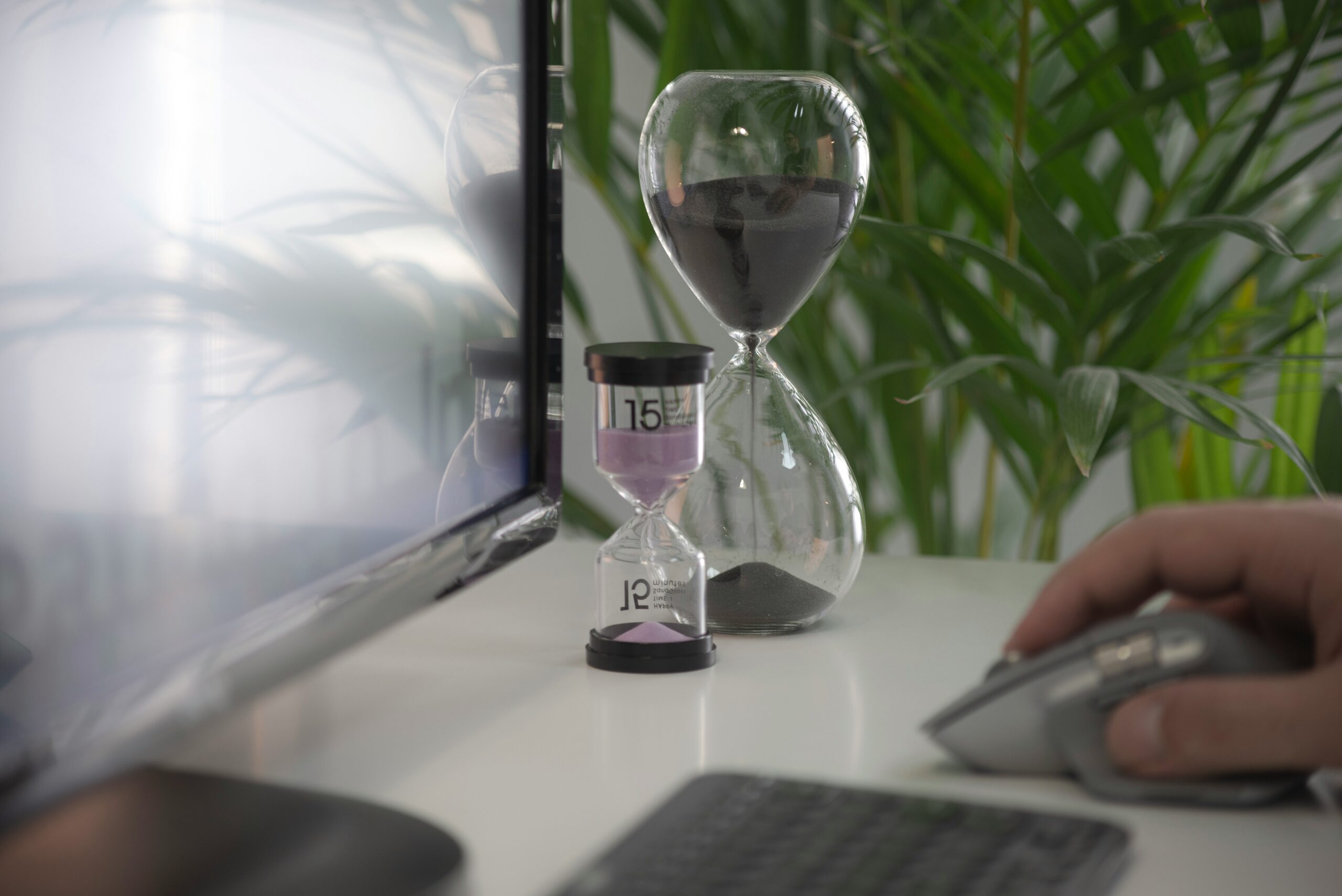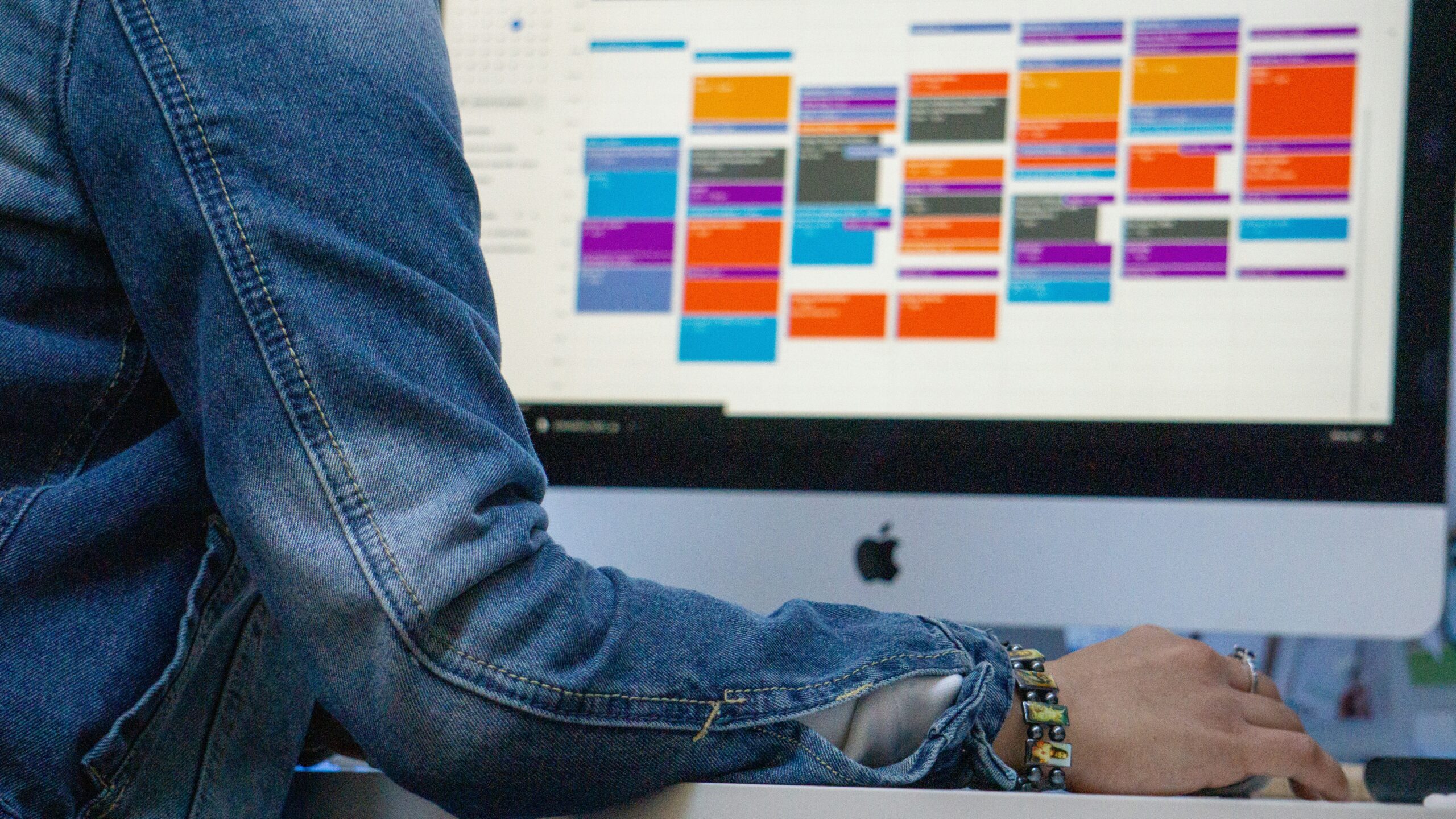The go to blog for ambitious professionals, who want to create sustainable career success despite chronic illness.
The 'Tired but Wired' Blog
Read this post →
Chronic Illness and Productivity Were Never Meant to Be a Perfect Match
If you’ve ever stared at your overflowing to-do list thinking, how am I supposed to tackle this when I can barely think straight?, you’re not alone. Chronic illness and productivity can feel like they’re constantly at odds: one demanding consistency, the other delivering unpredictability.
The truth is, most productivity systems weren’t designed for bodies or brains that run on fluctuating power. But here’s the good news: that disconnect isn’t a personal failure. It’s a sign that it’s time to stop forcing a fit and start building a new, better one.
This post is your permission slip to rewrite the rules. Because you deserve a work life that works for you, not one that quietly breaks you down.
💡 Want to start making changes today? Grab your free guide: 5 Powerful Strategies to Reduce Fatigue at Work
1. The 9-to-5 Grind Doesn’t Work for Chronic Illness (And Never Really Did)
Conventional work hours assume a predictable baseline of energy and focus, something that chronic illness simply doesn’t guarantee. But that doesn’t make you less capable. It just means the system was never set up with your reality in mind.
What to try instead:
Work with your natural energy windows, not arbitrary time slots. Track your personal highs and lows, and plan around them. This isn’t laziness, it’s intelligent adaptation.
2. Hustle Culture Rewards Burnout, Not Brilliance
You’ve probably been told that “pushing through” shows grit. But for those managing chronic illness, pushing through can lead to serious setbacks. What if protecting your energy was actually the smarter, more sustainable strategy?
What to try instead:
Use a “minimum effective effort” mindset: what’s the smallest action that gets you closer to your goal? Then celebrate that. Small, consistent steps > heroic burnout cycles.
3. Chronic Illness and Productivity Fluctuate Together… That’s Not a Problem, It’s a Pattern
Your energy isn’t the same every day, and your productivity shouldn’t be either. Treating every fluctuation as a red flag misses the point. This variability isn’t a weakness. It’s insight.
What to try instead:
Add flexibility buffers into your calendar. Build in time to reset after mentally or physically intense work. You’ll feel more in control, and less like you’re constantly catching up.
Need more proof? This download from the ME Association backs the importance of pacing and rest for managing long-term health.
4. You Don’t Need to Earn Rest, You Need to Honour It
When you live with chronic illness, waiting until you’ve “earned” rest can be a one-way ticket to burnout. Rest isn’t a luxury or a reward. It’s maintenance.
What to try instead:
Book your rest before you book your work. Even 10-minute breathers between calls can prevent the cumulative fatigue that tanks your whole day.
5. Redefining Success Can Set You Free
What if success wasn’t about keeping up? What if it was about creating work that fits you, your body, your pace, your values? That’s not lowering the bar. That’s raising it to a healthier height.
What to try instead:
Define your own version of success: maybe it’s one focused hour a day, or setting boundaries around your availability. Let go of the performative productivity and come home to what actually matters.
Final Thoughts: Rewriting the Rules is the Real Productivity Hack
If you’ve felt stuck, frustrated or like you’re quietly failing at a game you never chose to play, this is your reminder: you’re not the problem. The model is.
Chronic illness and productivity can co-exist, but only when we stop trying to force ourselves into outdated expectations.
Disclaimer:
The content in this blog is based on my personal experience of living with chronic illness and is shared for informational purposes only. It is not intended as a substitute for professional medical advice, diagnosis, or treatment. Always consult with your GP or healthcare professional before making any changes to your lifestyle, work routine, or health management. The tips and strategies shared here can be used alongside medical advice to support your well-being.

Read this post →
You finish work… but you don’t really stop. The emails have stopped pinging, sure. But your mind is still racing, your body is tense, and your to-do list has somehow grown a second head. If you’re living with a chronic illness or managing low energy day to day, trying to recharge on a weeknight might feel like an impossible ask. You’re running on fumes, but the idea of “self-care” sounds exhausting too.
This isn’t about forcing another routine. It’s about reclaiming your evenings, gently. With micro-changes that support your body, your boundaries and your bandwidth.
Let’s explore a few that actually make a difference.
1. The ‘Signal Stop’: Helping You Recharge on a Weeknight
When you work remotely, flexibly or while juggling a health condition, the lines between done for the day and still simmering mentally get blurred.
Try creating a ‘signal stop’, a small ritual that tells your brain it’s safe to power down. You could:
- Shut your laptop and put it physically out of sight
- Light a candle or switch on a lamp that you only use after hours
- Play a ‘clock-off’ playlist that marks the start of downtime
It’s not magic. But it’s a message. And over time, your body will start responding.
👀 Want more energy-saving strategies? Grab my free guide: 5 Powerful Strategies to Reduce Fatigue at Work.
2. Transition Time Isn’t a Luxury, It’s a Lifeline
Most people try to go straight from work brain to rest mode with no buffer. But if you’ve got lingering adrenaline or fatigue, you need a bridge, not a leap.
Try a 10–15 minute buffer that helps you regulate before you rest. That could be:
- A hot shower to literally and metaphorically wash off the day
- Journalling out the mental clutter
- Five minutes of stretching or sitting in silence
This isn’t time wasted. It’s time invested in recovery. You deserve that.
3. Permission to Rest Without Proving You Deserve It
One of the biggest energy leaks isn’t what we do, it’s how we feel about it. If you’re lying on the sofa but your mind is saying you should be doing more, that’s not rest. That’s guilt in yoga pants.
Let’s be clear: you don’t need to earn your rest. Especially if your body is doing extra behind the scenes, navigating fatigue, pain or just the ongoing mental load of managing life with a chronic condition.
Start by giving yourself explicit permission each night. You could even write it out or say it aloud:
I’ve done enough. I get to rest now.
✨ Need help reframing your beliefs around fatigue? Mind UK has helpful tools for navigating guilt, burnout and stress-related exhaustion.
4. Swap the Scroll for Something That Actually Feeds You
Let’s not demonise phone time, sometimes a scroll is all you’ve got energy for. But it’s worth asking: does this recharge me, or drain me further?
Instead, try having 1–2 go-to activities that feel more nourishing. Things like:
- Listening to a feel-good podcast
- Colouring in, journalling or doing a short creative hobby
- Sending a voice note to a friend (connection without pressure)
- Stepping outside and looking at the sky for 60 seconds
These don’t need to be ‘productive.’ They just need to give you back a little bit of you.
5. End the Day Before You’re Empty
So many of us push through until we’re completely spent and then wonder why the next day feels like wading through treacle.
Instead, pick a wind-down time and stick to it. Even if that means leaving the washing up until tomorrow or ignoring the email with the scary red exclamation mark.
You’ll sleep better. You’ll wake up less depleted. And you’ll start to realise that rest isn’t the reward, it’s part of the strategy.
Because Your Evenings Deserve Better
You weren’t designed to go full pelt all day, crash at night and call that balance.
If you’ve been feeling stretched thin, these small rituals are your reminder that you can recharge on a weeknight, without a big overhaul, and without waiting for the weekend to feel human again.
👉 Grab the free energy guide here: 5 Powerful Strategies to Reduce Fatigue at Work
Disclaimer:
The content in this blog is based on my personal experience of living with chronic illness and is shared for informational purposes only. It is not intended as a substitute for professional medical advice, diagnosis, or treatment. Always consult with your GP or healthcare professional before making any changes to your lifestyle, work routine, or health management. The tips and strategies shared here can be used alongside medical advice to support your well-being.

Read this post →
You’ve got your calendar set up. Meetings blocked, breaks pencilled in, tasks neatly tucked between Zoom calls. On paper, it looks manageable. Sensible, even. But by 2pm, you’re fried. Not “just a bit tired”, we’re talking foggy-brained, limbs-heavy, please-don’t-ask-me-one-more-thing kind of tired. If this sounds familiar, it’s not because you’re lazy, disorganised or bad at time management. It’s because your calendar is lying to you. Well, not intentionally. But it’s only showing part of the story, the time cost. It’s missing the invisible energy cost. And that’s where the real trouble starts.
What the Invisible Energy Cost Really Looks Like
Let’s say your calendar shows a 30-minute team check-in at 9am, followed by “quick admin” at 9:30, then a feedback review at 10. Looks fine, right?
But here’s what it doesn’t show:
- The emotional load of leading that team check-in
- The mental gymnastics of switching context for admin
- The cognitive effort of giving thoughtful feedback
Time-wise? Easy.
Energy-wise? Compounding fatigue.
One task might be short, but it might take a heavy toll. And stacking those tasks back-to-back, even when your calendar says there’s technically space, can leave you totally wiped.
The Cost of ‘Just One More Thing’
How often do you squeeze in an extra task, thinking “I’ll just get it done now to save myself time later”?
Spoiler: that “just one more thing” might be exactly what tips you into burnout territory. Because it’s not just a time issue, it’s a recovery issue.
If you keep pushing through without understanding the energetic weight of what you’re doing, you’re effectively borrowing against tomorrow’s capacity. And the interest rate is brutal.
3 Signs You’re Underestimating Energy Drain
- You’re always surprised by how exhausted you feel, even when the day looked light.
- You struggle to switch off at the end of the day, even when the to-do list is technically done.
- You’re avoiding certain types of tasks because they just feel heavier, even if they’re small.
Sound familiar? You’re not alone. This is one of the most common patterns I see with clients, especially those managing chronic health conditions or fatigue.
A Better Way: Plan for Energy, Not Just Time
This is where energy planning changes the game. Instead of asking, “Do I have time for this?”, try asking:
- “What kind of energy does this task require?”
- “What kind of energy do I have right now?”
- “How long will it take me to recover from this?”
Shifting to an energy-first mindset doesn’t mean doing less, it means doing smarter.
And yes, it might mean leaving a few white spaces in your calendar, not to be filled in later but held as recovery zones, space to reset your system, mentally and physically.
From Calendar Chaos to Capacity Clarity
Inside my 1:1 coaching programme, one of the first tools I share is your Energy Prioritisation Plan, a simple but powerful way to map out your work based on how much energy you have, not just how much time you’ve got.
It’s not about giving up on your goals. It’s about reaching them in a way that doesn’t cost your health.
If you’re not quite ready for coaching but you’re starting to rethink your day-to-day energy leaks, grab my free guide:
👉 5 Powerful Strategies to Reduce Fatigue at Work
For further reading on how your mental health and workplace energy are linked, check out this helpful guide from Mind UK: Taking Care of Yourself at Work
Disclaimer:
The content in this blog is based on my personal experience of living with chronic illness and is shared for informational purposes only. It is not intended as a substitute for professional medical advice, diagnosis, or treatment. Always consult with your GP or healthcare professional before making any changes to your lifestyle, work routine, or health management. The tips and strategies shared here can be used alongside medical advice to support your well-being.

Read this post →
If you’ve ever ended your day feeling completely wiped out, despite spending most of it sitting at your desk, you’re not alone. For many professionals, especially those living with a chronic illness, the real challenge isn’t time management. It’s managing energy at work.
But here’s the thing: most of us are managing it wrong. Not because we’re unmotivated, but because we’ve been trained to prioritise hustle over health and busyness over balance.
Let’s change that.
Below are five surprisingly common mistakes professionals make when managing energy at work and what to do instead for better focus, better flow and way less burnout.
1. Mistaking Busyness for Productivity
The drain:
You tick off a dozen tasks, but none of them move the needle. This kind of “busy work” eats up mental bandwidth but gives you very little back.
What to do instead:
Start your day by identifying your energy-worthwhile task: the one thing that, if done well, will make everything else easier. If you’ve only got one good hour in you today, spend it there.
2. Powering Through Fatigue
The drain:
You feel the slump, but push through anyway. By the time you stop, you’re not just tired, you’re wrecked.
What to do instead:
Take micro-breaks before fatigue hits. These short pauses protect your energy reserves and keep your mind sharp.
👉 Want to avoid the crash?
Download my free guide: 5 Powerful Strategies to Reduce Fatigue at Work. It’s full of practical, feel-good tools that work with your energy, not against it.
3. Over-checking Emails and Messages
The drain:
Constant checking = constant context switching = fragmented focus.
What to do instead:
Check your inbox 2–3 times daily and mute non-urgent notifications. Let your team know how to reach you for true urgencies.
4. Seeing Rest as Unproductive
The drain:
You fill downtime with admin because rest feels like laziness. Spoiler: it’s not.
What to do instead:
Block out white space in your calendar. Even just 10 minutes of true pause can help you reset and return with more clarity. Think of it as fuel, not fluff.
Want to understand more about why rest matters?
Want to understand more about why rest matters?
Take a look at Mind UK’s guide to workplace wellbeing, which covers how breaks, boundaries and balance are key to avoiding burnout and supporting long-term health.
5. Comparing Your Capacity to Others’ Output
The drain:
You try to keep pace with others, even when your body’s saying no.
What to do instead:
Honour your energy curve. Your capacity is allowed to shift. Build your schedule around that truth, not someone else’s timeline.
What Managing Energy at Work Really Looks Like
Managing energy at work isn’t about squeezing more out of yourself. It’s about working with your capacity instead of against it. It’s about knowing the difference between productivity and depletion and having the tools to choose the former.
To recap:
- Focus on impact, not activity
- Rest before you hit the wall
- Limit digital interruptions
- Reframe rest as a power move
- Respect your capacity
You’re not lazy. You’re not failing. You’ve just outgrown the one-size-fits-none version of productivity.
Disclaimer:
The content in this blog is based on my personal experience of living with chronic illness and is shared for informational purposes only. It is not intended as a substitute for professional medical advice, diagnosis, or treatment. Always consult with your GP or healthcare professional before making any changes to your lifestyle, work routine, or health management. The tips and strategies shared here can be used alongside medical advice to support your well-being.

Read this post →
We’ve all been sold the dream: hustle harder, manage your time better, and eventually, you’ll “make it.”
But if you’re living with a chronic illness, or even just a nervous system that says no thanks to relentless pressure, this version of success can leave you burnt out and barely functioning.
That’s where energy awareness and sustainable success come in. When you start making decisions based on your energy levels, not just your availability, you unlock a more honest, health-conscious way of working. One that honours your capacity and your ambition.
What Is Energy Awareness, Really?
Energy awareness is the skill of noticing your energy levels throughout the day and adjusting your behaviour accordingly.
It’s not just about taking breaks or doing yoga (although both can help). It’s about understanding your personal rhythms and knowing:
- What activities drain you vs. replenish you
- When your energy peaks and dips
- Which types of work feel worth the energy they cost
This is especially crucial if you’re managing symptoms like fatigue, brain fog or pain. Traditional time management tells you to block hours on a calendar. But energy-aware working asks: can I actually do this task, right now, in a way that won’t flatten me later?
The Power of Energy Awareness and Sustainable Success
Let’s be honest: productivity culture rewards people who ignore their bodies. But that doesn’t work if your body is already shouting at you.
Energy awareness and sustainable success go hand in hand. You can’t build a thriving, fulfilling career by constantly borrowing energy you don’t have.
When you make decisions based on energy (not guilt, deadlines or other people’s expectations) you:
- Get more done in less time
- Protect your mental and physical health
- Make room for creativity and clarity to flourish
This shift in mindset doesn’t make you weak, it makes you strategic.
For a grounded perspective on energy and workplace wellbeing, Mind UK offers excellent resources on mental health at work and energy management.
The Real Cost of Ignoring Your Energy Limits
When you override your body’s signals for long enough, the price shows up as:
- Constant fatigue, even after rest
- Brain fog during key meetings
- Irritability and mood crashes
- A creeping resentment for a job you once enjoyed
This is what I call the energy debt cycle, where you spend more than you have, and then pay it back with interest (usually in the form of sick days, guilt, or a full-on crash).
If this sounds familiar, you’re not alone, and you’re not broken. You’ve just been taught to manage time, not energy.
3 Practical Shifts to Start Working With Your Energy (Not Against It)
1. Track Your Energy, Not Just Your Tasks
Try a simple energy audit: for 3 days, jot down your energy levels (1–5) at key times: morning, midday, afternoon, evening. Note what you were doing at the time.
Patterns will emerge. And those patterns? They’re gold dust.
➡️ Want a done-for-you version? Grab my free guide: 5 Powerful Strategies to Reduce Fatigue at Work
2. Plan Your Work Around Your Peaks
If you notice your energy spikes at 10am, protect that slot like a dragon guarding treasure. Use it for the work that matters most: strategy, writing, problem-solving.
Save admin, inbox-clearing and low-energy tasks for your dips.
This one shift can save you hours of wasted effort.
3. Learn to Pause Before the Crash
This one’s hard if you’ve spent years pushing through. But learning to pause before the overwhelm hits is a radical act of self-leadership.
Try a 3-minute rule: when you feel that energy dip coming on, take a break before you think you “deserve” it.
You don’t need to earn rest, you need to honour your bandwidth.
This Isn’t Laziness. It’s Leadership.
Rebuilding your relationship with energy isn’t just about preventing burnout.
It’s about leading your work, and your life, with intention.
Energy awareness and sustainable success isn’t a fluffy wellness concept, it’s a business-critical strategy. Especially if you’re living with chronic illness, this approach helps you lead and deliver without the cost being your health.
You don’t have to burn out to prove your value. Your energy is not a problem to be solved, it’s a compass to follow.
Further Reading
- Mind UK: Tips for workplace mental health
- The Spoon Theory – A Helpful Analogy for Chronic Illness and Energy Management
Disclaimer:
The content in this blog is based on my personal experience of living with chronic illness and is shared for informational purposes only. It is not intended as a substitute for professional medical advice, diagnosis, or treatment. Always consult with your GP or healthcare professional before making any changes to your lifestyle, work routine, or health management. The tips and strategies shared here can be used alongside medical advice to support your well-being.

Read this post →
Let’s Talk About the Lie We’ve Been Sold About Success
You know the one. Hustle harder. Sleep when you’re dead. Keep pushing through, no matter what. For most people, this message is exhausting. But if you’re living with a chronic illness? It’s not just exhausting, it’s dangerous.
And yet, you still want more. Not in the capitalist, 60-hour week kind of way, but more meaning, more contribution, more fulfilment. That’s not selfish. It’s human. You’re allowed to be ambitious and unwell. The problem is, you’ve been taught to chase someone else’s version of success that doesn’t fit your reality.
It’s time to redefine what sustainable success with chronic illness actually looks like and why it’s not only possible, but powerful.
What Does Sustainable Success Really Mean?
Sustainable success with chronic illness isn’t about settling or playing small. It’s about choosing goals, systems and rhythms that fuel your ambition without draining your body.
It’s when:
- You build a career or business that works with your energy, not against it.
- You define productivity based on impact, not hours.
- You say yes to growth that fits inside your bandwidth.
- You rest without guilt because it’s part of the plan, not a reward.
It’s not small. It’s smart. It’s success that you can keep showing up for.
Real Examples of Sustainable Success with Chronic Illness
Here are some subtle (but powerful) ways people have redefined their careers and businesses for the better:
1. From Big Launches to Consistent Income
Instead of pushing for adrenaline-fuelled product launches that led to week-long crashes, one business owner moved to evergreen offers and monthly retainers. Same income goal, just delivered in a way her body could keep up with.
2. From Promotions to Portfolio Careers
One former marketing exec restructured her work into a mix of part-time consulting and mentoring, still impactful, still strategic, but with breathing room for flares and fatigue.
3. From Full-Time to Fulfilment-Focused
A teacher with MS reduced her hours to three days a week and used her remaining energy to create a resource bank for others with similar conditions. She didn’t scale down, she scaled better.
Each of them moved toward sustainable success with chronic illness by ditching other people’s definitions and building lives that work for them.
Your 4-Step Framework for Sustainable Success
Want to begin redefining your own version of success? Start with these:
Step 1: Challenge Your Definition
Ask yourself: Whose version of success am I aiming for? Society’s? A younger, healthier version of me? Someone who doesn’t need to ration their spoons?
Step 2: Reconnect to Your Values
What really matters to you, freedom, purpose, security, flexibility? Your values should shape your goals, not the other way around.
Step 3: Align Your Energy and Ambition
You can still aim high. But your delivery model needs to match your body’s capacity. If you need help with this, grab my free guide: 5 Powerful Strategies to Reduce Fatigue at Work.
Step 4: Prioritise Rest Like a CEO
Rest isn’t laziness. It’s leadership. When you plan for rest the same way you plan your meetings, you protect your ability to keep showing up.
For a medically grounded overview of how to manage chronic fatigue day-to-day, check out this NHS guide to managing fatigue, it covers both medical and lifestyle approaches that support the strategies I share here.
Why This Matters (And What to Do Next)
You don’t have to choose between ambition and well-being. You can still grow, build and thrive, without burning yourself out.
The key to sustainable success with chronic illness is alignment: aligning your work with your values, your goals with your energy, and your definition of success with what actually matters to you.
If you’re ready to move from “just getting by” to a more energised, purpose-filled way of working, my 1:1 coaching can help. I work with professionals living with chronic illness to create personalised, values-led strategies for success that honour your health and your goals.
➡️ Learn more about coaching or book a discovery call here
Disclaimer:
The content in this blog is based on my personal experience of living with chronic illness and is shared for informational purposes only. It is not intended as a substitute for professional medical advice, diagnosis, or treatment. Always consult with your GP or healthcare professional before making any changes to your lifestyle, work routine, or health management. The tips and strategies shared here can be used alongside medical advice to support your well-being.

Read this post →
If you live with a chronic illness, your relationship with work might be… complicated. You want to contribute, stay ambitious, and make a difference. But the traditional path to success often comes at the expense of your energy, your body, and sometimes your sanity. Here’s something many of us were never told: Joyful workdays aren’t indulgent. They’re necessary.
In fact, small sparks of joy can lower stress, improve your cognitive function, and even reduce inflammation – which is a big deal when your body is already working overtime. So if you’ve ever thought, “I’ll enjoy work when I’m feeling better” – flip that. You might just feel better because you’re enjoying work.
The Science Bit (Don’t Worry, It’s Brief)
Joy isn’t just an emotion. It’s a physiological state that releases neurotransmitters like dopamine and serotonin, which actively reduce the body’s stress response. For people with chronic conditions, that can mean less cortisol flooding your system and more space for your body to recover.
According to this gov.uk article, positive mental wellbeing is directly linked to better physical health outcomes and reduced risk of chronic illness complications.
In short: joy isn’t a side effect of health. It can help create it.
5 Ways to Create Joyful Workdays Without Burning Out
1. Start Your Day with a Win (That Isn’t Work-Related)
Joyful workdays often begin before you even log in. Whether it’s a cup of your favourite tea, five minutes of sunlight, or a song that makes you feel alive – create a ritual that fills you up, not just your calendar.
Bonus tip: Track the tiny habits that help you feel more energised. This data is gold for your pacing strategy.
2. Schedule Joy Like You’d Schedule a Meeting
We book calls, deadlines and appointments. But rarely block time for anything that lights us up. Add 15 minutes of “delight time” into your day. It could be a podcast, a stretch, a phone call with someone who gets it – anything that feels like yours.
Need more support managing your energy at work? Download my free guide:
👉 5 Powerful Strategies to Reduce Fatigue at Work
3. Ditch the Guilt Around Breaks
You’ve probably internalised the idea that breaks = laziness. That’s nonsense. Breaks are when your brain resets, your body recalibrates, and your nervous system gets a breather. No one gets a medal for burnout.
And no, scrolling LinkedIn while eating lunch doesn’t count.
4. Align Tasks with Your Energy Peaks
Joy flows easier when we stop swimming upstream. Are you sharper in the mornings? Save admin for the afternoon. Do creative work when your mind’s clearer. It’s not just efficient. It’s empowering.
Pro tip: This energy-first approach is a core principle of my 1-hour masterclass, where I show you how to build sustainable work rhythms that actually work with your body, not against it.
5. Notice the Joy When It Happens
We’re wired to spot problems, not pleasures. But training your brain to notice micro-moments of joy (a nice email, a task ticked off, a colleague’s kindness) rewires your focus. It’s subtle. But it adds up fast.
Try this: at the end of each day, jot down one thing that brought you a moment of lightness. That’s it. Just one.
This Isn’t About Toxic Positivity
This isn’t a call to slap a smile on and pretend everything’s fine. It’s about reclaiming small, accessible ways to feel better without needing to overhaul your job or your life. Joy can sit alongside pain, stress, and uncertainty. But when we let it in, even in tiny doses, it changes the way we cope.
Conclusion: Joy Is a Health Strategy
Joyful workdays aren’t a luxury for “when things calm down”. They’re part of the foundation that helps you get through the day with less pain, more energy, and a stronger sense of self. You deserve that. Not once you’re better. Now.
Disclaimer:
The content in this blog is based on my personal experience of living with chronic illness and is shared for informational purposes only. It is not intended as a substitute for professional medical advice, diagnosis, or treatment. Always consult with your GP or healthcare professional before making any changes to your lifestyle, work routine, or health management. The tips and strategies shared here can be used alongside medical advice to support your well-being.

Read this post →
Let me guess, you’ve caught yourself saying:
- “I can rest when I finish this deadline.”
- Or, “I’ll slow down after the launch.”
- Or the classic: “Rest is for the weekend.”
Sound familiar?
If you live with a chronic illness, this mindset isn’t just exhausting, it’s unsustainable. And it’s probably one of the last things your body needs. But here’s the kicker: even those of us who know better still fall into this trap. We’ve been trained to tie rest to productivity, as if we need to earn permission to stop.
So today, we’re flipping that script. Because rest without guilt isn’t indulgent, it’s strategic. And when you get it right, it becomes one of your most powerful tools for doing meaningful work without burning out.
1. The ‘Earned Rest’ Mindset: Where Did We Even Get This From?
Let’s be real: the idea that rest must be earned is rooted in hustle culture. We’re taught to glorify exhaustion, idolise overwork, and shame ourselves for needing downtime. This toxic pattern shows up everywhere, from our workplaces to our social media feeds.
For professionals managing chronic illness, this mindset isn’t just outdated, it’s dangerous. When you feel you have to “justify” every break, you’re far more likely to push through warning signs and trigger flares, crashes or relapses. And then what? You’re forced to rest but this time, it’s reactive, not restorative.
2. Rest Isn’t Lazy, It’s Leadership
Imagine if we treated rest as part of the strategy, not the reward.
Because the truth is, rest without guilt sharpens your thinking, improves your mood, and helps you show up better, for your clients, your colleagues, and most importantly, yourself.
💡 In fact, the NHS highlights how rest is vital for managing stress, improving mood, and supporting overall mental wellbeing. Regular restorative breaks protect both cognitive and emotional health, something that’s especially crucial when chronic illness is part of your daily reality.
So no, resting isn’t lazy. It’s leadership. Especially when you’re building a sustainable, values-aligned career with limited energy reserves.
3. Spot the Shame Triggers (And Call Them Out)
Here’s something I see all the time in my community:
You take a break… but spend the entire time feeling guilty about it.
That kind of “rest” isn’t rest at all. It’s shame in a different outfit.
Instead of defaulting to guilt, try asking yourself:
- Would I shame a friend for taking this break?
- Am I resting to recover… or avoiding rest because I think I haven’t ‘earned’ it yet?
Notice the internal narratives that sneak in, and interrupt them with truth.
4. Simple Ways to Practise Rest Without Guilt
You don’t have to overhaul your entire schedule to rest well. Sometimes it’s the tiny, regular pauses that make the biggest difference. Here’s where to start:
- Bookend your day with intentional recovery Even five minutes of quiet breathing, journaling or stretching helps create a boundary between ‘on’ and ‘off’.
- Use the 90-minute energy rhythm Research shows our brains naturally work in 90-minute bursts. After each block, pause… Yes, even if you’re ‘on a roll’.
- Try a ‘non-negotiable break’ mindset Treat rest like a meeting you wouldn’t cancel. It deserves the same respect.
Want more practical strategies to reduce fatigue at work?
👉 Grab my free guide: 5 Powerful Strategies to Reduce Fatigue at Work
5. Redefine Rest as a Tool for Growth
Rest doesn’t mean stepping away from your ambition. It means showing up for it differently.
What if your rest time is when your next big idea brews quietly in the background? What if slowing down was what helped you finally get the clarity or momentum you’ve been missing?
Instead of using rest as a reward, use it as a resource, one that fuels your sustainability, creativity and capacity.
Ready to Work Smarter (Not Sicker)?
If this post hit home, it’s because you already know the old rules don’t work anymore. You’re not lazy. You’re strategic. And you deserve a work rhythm that honours your body and your brilliance.
✨ That’s exactly what we focus on in my 1:1 coaching.
I help ambitious professionals living with chronic illness shift away from burnout-prone habits and build careers that support both their health and their goals. Whether you’re navigating workplace expectations, energy crashes or the never-ending pressure to prove yourself, I’ll help you carve out a path that works for you, not against you.
Together, we’ll:
- Unpick the patterns that drain your energy and self-worth
- Create work systems that match your real capacity (not the one you wish you had)
- Rebuild your professional confidence without sacrificing your wellbeing
👉 Find out more about coaching with me
Want more like this?
Sign up to my newsletter for honest, practical strategies on working with chronic illness, without losing your drive or your mind. It’s like a pep talk and a productivity tip sheet, rolled into one.
Disclaimer:
The content in this blog is based on my personal experience of living with chronic illness and is shared for informational purposes only. It is not intended as a substitute for professional medical advice, diagnosis, or treatment. Always consult with your GP or healthcare professional before making any changes to your lifestyle, work routine, or health management. The tips and strategies shared here can be used alongside medical advice to support your well-being.

Read this post →
Are You Working to Prove Your Worth?
You know the feeling: the workday ends, but your mind doesn’t. You’ve ticked off tasks, pushed through pain, and still feel like you haven’t done “enough.” If you’re a professional living with chronic illness, this relentless drive isn’t just about productivity. It’s often rooted in something deeper.
The link between overwhelm and identity is powerful. When your sense of self-worth becomes entangled with how much you do, you start working to prove your value rather than to preserve your wellbeing. That’s when the real exhaustion begins.
Let’s unpack where this comes from and how to begin loosening its grip.
1. How Overwork Becomes a Measure of Self-Worth
When you live with limited energy, it’s easy to feel like you have something to prove. You might work harder, longer, or say yes to more than you can realistically manage. Not because you want to, but because you’re afraid not to.
You might catch yourself thinking:
- “If I over-deliver, no one will question my commitment.”
- “If I say no, they’ll think I’m unreliable.”
- “If I rest, they’ll think I’m lazy.”
But these thoughts don’t come from nowhere. They’re often shaped by the deeper link between overwhelm and identity, where doing more becomes a way to feel enough.
2. Internalised Ableism and Perfectionism: A Hidden Burnout Trap
One of the hardest things to spot is how deeply we internalise the belief that we must keep up. When rest is framed as weakness and adjustments feel like failure, it becomes nearly impossible to work in a way that honours your body.
This is internalised ableism in action, and it shows up in all kinds of sneaky ways:
- Feeling guilty for using accommodations
- Masking pain or fatigue to appear “professional”
- Overcompensating to avoid judgement or exclusion
This internal pressure often pairs with perfectionism, creating a cycle of over-functioning and eventual burnout.
📰 Related reading: One person’s experience of working with internalised ableism.
3. Redefining Value Without the Hustle
Here’s the truth: your value isn’t earned through exhaustion.
The moment you begin separating your identity from your output, you take back control. That doesn’t mean lowering your standards. It means changing the measure of success. Ask yourself:
- Is this task aligned with my values?
- Will this choice support my energy?
- Am I acting from self-worth or seeking validation?
This is where real, sustainable change begins. This is where the link between overwhelm and identity starts to loosen.
If you’re struggling with burnout or overwhelm, Mind’s resource on work-related stress offers further insight into the emotional toll of chronic pressure, especially when it stems from internalised expectations.
4. A New Definition of Success That Includes You
Imagine a version of success that doesn’t ask you to sacrifice your health. A version where your identity is grounded in who you are, not what you produce. It might sound radical, but it’s entirely possible.
The first step is redefining what “enough” looks like in your own terms. Not in comparison to colleagues. Not by what your productivity app says. But by how aligned your work feels with your needs, capacity and values.
That redefinition is an act of courage and self-trust.
5. Ready for the Next Step? Awareness Is the Beginning
Understanding the link between overwhelm and identity is more than just an “aha” moment. It’s a call to reconnect with the version of you who isn’t constantly proving, pushing or performing.
And you don’t have to do it alone.
Before You Go: Build a Foundation for Sustainable Energy
If you’re not ready for the deeper identity work just yet, start by protecting your energy. My most downloaded free guide offers practical, evidence-based shifts to reduce fatigue at work without sacrificing your impact.
Want More Gentle Strategy and Support?
Each week, I send out a short, thoughtful email designed to help you thrive with chronic illness, at work and beyond.
💌 Join the newsletter for tools, reflections and mindset shifts that help you grow without burning out.
Disclaimer:
The content in this blog is based on my personal experience of living with chronic illness and is shared for informational purposes only. It is not intended as a substitute for professional medical advice, diagnosis, or treatment. Always consult with your GP or healthcare professional before making any changes to your lifestyle, work routine, or health management. The tips and strategies shared here can be used alongside medical advice to support your well-being.

Read this post →
When you’re living with a chronic illness, work can easily become your whole world. It’s the thing that pays the bills, defines your routine, and, if we’re honest, can feel like the only “productive” use of your limited energy.
But here’s the truth: reconnecting with joy outside of work isn’t a luxury. It’s a necessity. Without it, your world becomes smaller, your energy drains faster, and your sense of self slowly fades behind a job title or a diagnosis.
In this blog, you’ll learn why prioritising joy is a vital step toward sustainable success, how it supports, not competes with, your productivity, and simple ways to bring non-work passions back into your life.
The hidden cost of neglecting reconnecting with joy outside of work
When you’re flat-out juggling work and health, joyful activities are often the first thing to go. You tell yourself it’s temporary. Just until you “catch up.” But the weeks turn into months.
While it’s easy to think of joy and well-being as “mental health” topics, there’s strong evidence that they also have a direct impact on physical health, especially for those living with long-term conditions.
For example, the NHS explains how stress can worsen chronic physical health problems, including fatigue, pain, and immune function (NHS Stress and Long-Term Conditions). Activities that reduce stress, spark joy, and promote emotional well-being can therefore support your physical health, not just your mood.
Without joy:
- Fatigue worsens because there’s no mental or emotional recharge.
- Your self-worth becomes tangled up in productivity.
- Work-life balance becomes non-existent.
So reconnecting with joy isn’t an indulgence, it’s a vital strategy to support both your mental and physical health.
Rest isn’t the opposite of productivity, it fuels it
Many of my clients used to think rest and joy were indulgences they couldn’t afford. I get it. I used to think the same. Until I burnt out so badly that I had no choice but to reassess.
Here’s a reframe that helped me (and now helps my clients):
Rest and joy are active ingredients in sustainable productivity.
When you intentionally make space for non-work joys, you’re:
- Giving your nervous system a break from constant output.
- Replenishing creative and emotional energy.
- Building resilience against future burnout.
This shift aligns perfectly with my free resource, 5 Powerful Strategies to Reduce Fatigue at Work, which offers practical tools to reclaim your energy without sacrificing success.
How to start reconnecting with joy outside of work, without adding more pressure
When work and illness take up all the oxygen, it’s easy to forget what used to bring you joy. Here’s a simple exercise to reconnect:
- Think back to “pre-busy” you. What hobbies, activities, or moments made you lose track of time?
- Notice small sparks. What feels nice now, even if only for a minute? A warm cup of tea? A walk in fresh air?
- Start small, but consistently. You don’t need hours. Even 10 minutes of something joyful is a powerful reset.
The goal isn’t to add more “to-dos” to your day. It’s to gently widen your world beyond work and health demands.
Protecting your joy-time: Practical tips for sustainable success
To make joy a non-negotiable part of your week:
- Schedule it like a meeting. Block time for activities that light you up.
- Set boundaries around work hours. Hard stops help preserve energy for personal joys.
- Combine with rest. Some activities can be both joyful and restorative, like gentle crafting, mindful walking, or reading for pleasure.
- Ask for support. Let family or colleagues know you’re reclaiming time for yourself.
For more ways to create space in your workday, subscribe to The Sunday Power-Up—my weekly newsletter packed with energy-saving tips and strategies for professionals like you.
The emotional impact of reconnecting with joy outside of work
Reintroducing joy into your life isn’t just about feeling good in the moment. It’s about:
- Reaffirming your identity beyond “worker” or “patient.”
- Building emotional resilience.
- Strengthening your capacity for meaningful work and meaningful rest.
When you focus on reconnecting with joy outside of work, you’re not stepping away from success, you’re creating a foundation for it.
Ready to reclaim your energy for what matters most?
If this post resonated, and you’re ready to create a more balanced, fulfilling way of working that respects your health, my 1:1 coaching services are designed to help.
Together, we’ll explore practical strategies to manage your energy, align your work with your personal values, and bring joy back into your life beyond the confines of work and illness.
👉 Learn more about my coaching services here.
Disclaimer:
The content in this blog is based on my personal experience of living with chronic illness and is shared for informational purposes only. It is not intended as a substitute for professional medical advice, diagnosis, or treatment. Always consult with your GP or healthcare professional before making any changes to your lifestyle, work routine, or health management. The tips and strategies shared here can be used alongside medical advice to support your well-being.

JOIN THE FAMILY
You may unsubscribe from these communications at any time. See our privacy policy for terms and conditions and to learn how we protect your data.
Become part of my family and get access to content that no-one else has!
Like practical tips, workbooks, resources and more, straight to your inbox 📧 Don't forget to tick the checkbox to receive these!